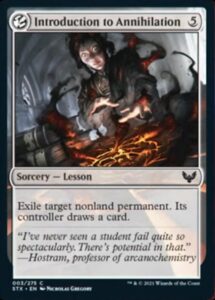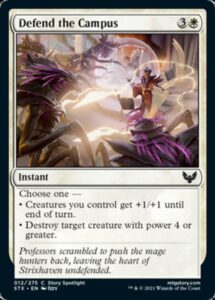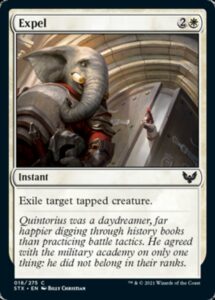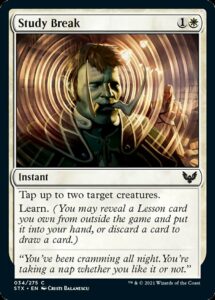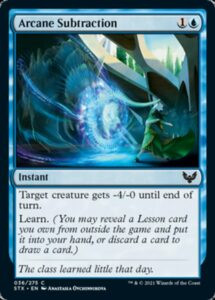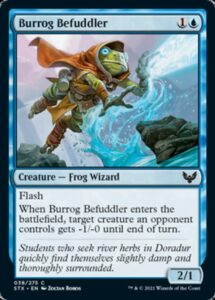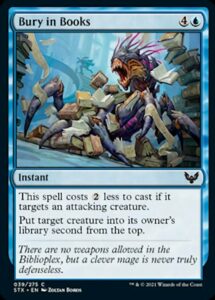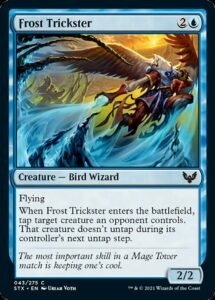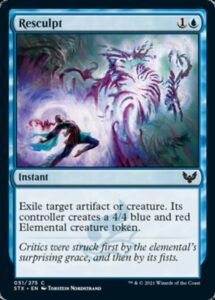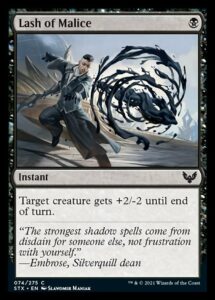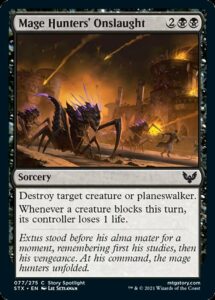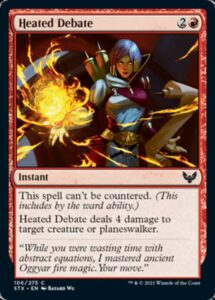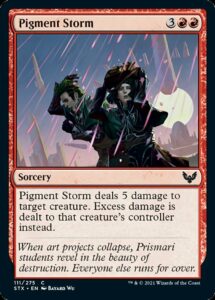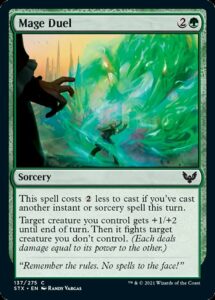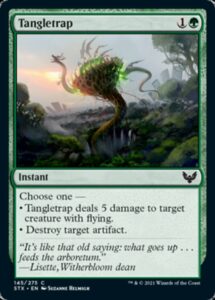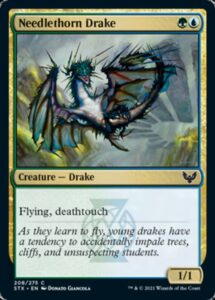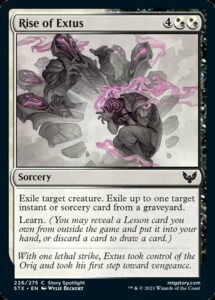Interaction defines Limited. When common removal spells are good, creatures get worse. When common removal spells are awkward or expensive, creatures get better. This tension exists in all Limited formats, defining pick orders, how powerful synergies can be (depending on how disruptable they are), and how card important card advantage is (it matters less when creatures are hard to answer). Understanding a format’s interaction is as essential as understanding its archetypes and crucial to drafting well.
Last week, we covered Strixhaven’s mechanics and archetypes. Today, we’re moving from a macro view to the micro and looking at individual cards. And it should come as little to surprise that we’ll focus on the most important cards for draft: common removal.
Colorless
There’s only one colorless removal spell in Strixhaven, and it’s a harder one to evaluate than cards like Scalding Cauldron. Introduction to Annihilation is an awful card to put in your deck—five mana sorceries are just too expensive nowadays, and that’s before factoring in that your opponent gets to draw a card, too!
However, that’s an argument for never putting Introduction to Annihilation into your deck, but not an argument for not playing it. As long as you have enough good Learn spells, you can always have the option of grabbing Introduction to Annihilation to exile something you cannot beat. This doesn’t feel like a high pick, but I wouldn’t be surprised if having one copy of this in the sideboard will provide a lot of protection.
White
Smite the Monstrous and Charge are not good spells. They require specific situations to shine and can spend games rotting in your hand, never doing what you need them to do. Staple them together, and you get more than the sum of their parts. Defend the Campus seems ideal for a Silverquill (WB) go-wide deck, where it’s an anthem when you’ve got good attacks and a removal spell when your opponent is beginning to stabilize. I’m still skeptical, since combining two weak effects rarely makes a high power common, but the flexibility should make this one of the better Smite variants we’ve seen in a while.
Expel is the premium white removal spell in Strixhaven. It’s far easier to use on defense, making this more often a tool for Lorehold (WR) than Silverquill. The problem with spells like Take Vengeance is that your opponent needs to cooperate by tapping their creatures (unless you’ve got access to repeatable tappers, something white lacks in Strixhaven). This being instant speed and relatively inexpensive covers the usual weaknesses of this effect, but I see this a medium tier removal spell rather than something outstanding like Demon Bolt. And as white’s likely best common removal spell in Strixhaven, that suggests white will be finding its power in subjects other than annihilation.
Every now and then, aggro decks can employ bursts of tapping to get through damage, but even the most potent Falters tend to struggle unless they have an additional benefit (such as Ardenvale Tactician). Repel the Darkness was never a strong card, and while Study Break is cheaper, Learn is costed to be less valuable than drawing a random card.
There don’t seem to be many Lessons that a control deck would want to justify throwing away a Study Break to gain some life, nor are there many Lessons an aggro deck would want to follow up with the afterwards. My gut says this is a generally weak card that every now and then will be used to tap two creatures and win the game; maybe with everyone durdling, that’ll be good enough more often than it would seem.
Overall, white’s removal seems below par. All of it is conditional and there is no one spell that can proactively answer any creature. Perhaps it’s a function of how split white is as a color—with WB as the aggro deck and RW as a control deck, but white will need to rely on other strengths and other colors rather than its own interaction.
Blue
As I’ll keep saying, Learn is a difficult mechanic to evaluate. It looks quite weak, since it adds 1 mana to a cost whereas drawing a card adds 2, and Lessons are generally overcosted spells. I have low expectations here, given that the easier-to-use Befuddle and more powerful Chilling Trap were never that good, and Chilling Trap supported a UR spells theme akin to Strixhaven’s Magecraft.
I appreciate that blue’s now regularly getting interactive flash creatures like Zulaport Duelist and Brinebarrow Intruder, as they enable aggressive strategies that require proper timing to enable—the exact right feel for blue aggro. The difference with our froggy friend is that two power makes it an acceptable (if unexciting) combatant. The fail case of a 2/1 flashing in at the end of your opponent’s turn is far, far better than having a 1/1 or 1/2. This doesn’t seem like a high pick, but you should always keep it in mind during combat, either to strike fear into those who’d respect it or blow out those who don’t.
While white is stuck with situational interaction, blue gets a powerful removal spell that situationally becomes incredible. This looks to be a high-quality removal spell that works fine on offense and incredibly well on defense or when racing. Don’t discount the additional demoralization value when your opponent is forced to redraw their now wildly off curve threat. This seems solid and could even be great, depending on how the format shakes out.
Sometimes blue gets to have it all. Frost Trickster seems like not only the best blue common, but one of the best commons in the set. This marriage of Frost Lynx and Wind Drake is potent disruption for all speeds of deck. The only knock against it is that it has no interaction with any of the set’s themes, but Strixhaven’s themes are loose and there’s no shame in having generically awesome cards.
Angelic Ascension wasn’t a great removal spell and was a fine (but risky) way to upgrade one of your own creatures. Resculpt is likely to be in the same vein. Sure, every now and then you can answer an elder dragon or Resculpt your creature before a removal spell hits it, but more often than not this’ll be card disadvantage. Theoretically, you could combine this with Prismari’s treasure subtheme to make a 4/4 out of thin air, but there’s scant treasure production and much of it requires you to spend a card.
It’s good to have an array of both high and low quality removal spells, and while Resculpt is on the low end, blue seems to have made out like a bandit in Strixhaven.
Black
Black only has two removal spells to blue’s five, which is unusual, but both of them are outstanding. Lash of Malice is a weaker Disfigure—every now and then you can use it to push through some extra damage, but you can’t use it to shrink and eat a creature in combat and run the risk of being blown out even more by an opponent’s combat trick. Despite all that, this is an excellent removal spell. The only question is whether this is better or worse than Mage Hunters’ Onslaughter, and that depends on the speed of the format and the size of the average creature.
Four mana creature unconditional removal vacillates between being incredible and serviceable. Mage Hunters’ Onslaught spans that gap by being substantially better in aggressive decks while still being strong in slower ones. By itself, this can easily be “Destroy target creature. Its controller loses 3 life” and its ceiling can go even higher if you’ve got a small army of Pesters. Sure, it’s sorcery speed and not splashable, but splashability matters less in five faction formats and both black colleges seem able to take advantage of its aggressive slant.
Red
Bombard was a top tier common. Heated Debate is a strictly better version. This is cheap and splashable enough to go in a variety of decks, four damage kills most relevant creatures, and it even hoses Ward. This is in the running for best common overall.
There’s always an aggressively costed red burn spell in the 1-4 mana range, and usually a more expensive and weaker one at five mana. Pigment Storm is exactly that, though having Trample makes it an interesting aggressive tool. It’s enough damage to kill almost anything, but you could also point it at your opponent’s smallest creature (or most damaged creature post-combat in some bizarre situation) to force through four points of damage.
Red doesn’t have a lot of tools in Strixhaven, but its two removal spells are quite potent.
Green
Epic Confrontation is a powerful spell. At three mana, it’s not quite as exciting, especially when compared with Struggle for Skemfar, but it’s still strong. It shouldn’t be too difficult to cast Mage Duel for one mana, and when you do, it’ll likely be an absolute beating.
Fight spells rarely beat out easy-to-use removal spells like Heated Debate and Frost Trickster as best common removal spell. I don’t think it does here, but this is one of the stronger fight spells we’ve seen in some time.
Just as red always gets at least two burn spells in every set, green gets some combination of a fight spell, a Naturalize,and a Plummet. Tangletrap combines two of them into a card that probably should stay in your sideboard and out of your BO1 decks entirely.
Multicolor
Deadly Recluse was once known as the green Doom Blade. Clearly, Needlethorn Drake is the Quandrix Doom Blade. It’ll trade for almost anything in combat, it’ll rock at Mage Duels, and it’ll reward you for being in Quandrix far more than it’ll reward you for splashing it.
We end on the most difficult removal spell to evaluate in the entire set. Rise of Extus is the missing unconditional removal spell in white and the expensive removal spell in black. A six mana sorcery is well below par nowadays. Mild graveyard disruption seems unlikely to be meaningful in most games. But Learn is, well, still hard to evaluate. If you’ve got the time to durdle around for a while, Rise of Extus is two-for-one, and that’s nothing to sneer at. Moreover, because Strixhaven is a faction set, Rise of Extus is castable in three of five colleges, making it a highly versatile card. I’m not saying it’s a high pick, but if the format is slow enough, nabbing a creature and summoning a mascot is a huge play.
And that’s all the common removal in Strixhaven. There seems to be less than we had in Kaldheim (which is hardly a problem—formats should vary the power levels and color-foci of their removal), with blue having some surprisingly powerful tools. Black, red, and green all enjoy a few strong tools while white seems to have gotten the short end of the stick. In just a few short days, we’ll get to put these spells to the test with Strixhaven’s digital release on Thursday. Here’s hoping you have a blast with your prereleases and that we’ll soon enough be able to safely have them on actual tabletops.
And, as always, thanks for reading.
Zachary Barash is a New York City-based game designer and the commissioner of Team Draft League. He designs for Kingdom Death: Monster, has a Game Design MFA from the NYU Game Center, and does freelance game design. When the stars align, he streams Magic (but the stars align way less often than he’d like).

